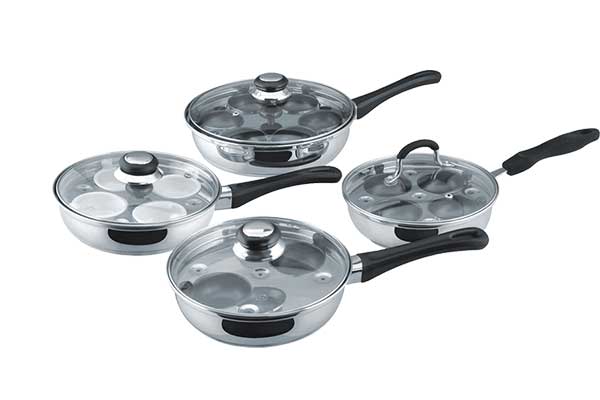With the development of modern industry and the progress of human science and technology, various kinds of metal based pots and pans emerge in endlessly. At present, the metal pots and pans sold on the market are mainly divided into the following categories: aluminum pot, copper pot, iron pot, stainless steel pot for export, non stick pot and titanium alloy pot. Due to different metal materials, these kinds of pots and pans have their own advantages and disadvantages in actual use. Now Xiaobian said to all the guests.
1. aluminum pot
The aluminum pot is light, fast and even in heat transfer. Because the metal surface is covered with a layer of aluminum oxide, it can protect the pot from rusting. The experiment shows that under the action of strong alkali, the protective layer of alumina will not be damaged in a short time, so the aluminum pot is more durable.
In daily use, many people like to use steel wire balls to polish the aluminum pan when they brush the pan. Although the oil on the pan is wiped off, the protective oxide film is also damaged. When the temperature is too high or acid or alkaline food is cooked, the aluminum in the pan will migrate to the food and accumulate in the human body. The long-term intake of excessive aluminum will damage the brain, cause Alzheimer's disease, and may also lead to osteoporosis, anemia and other diseases. The excessive aluminum in the body of pregnant women will affect the development of the fetus.
In the label of aluminum pot products, the material shall be aluminum alloy and corresponding brand according to GB 4806.9-2016 national food safety standard metal materials and products for food contact.
2. copper pot
Copper is one of the earliest metals discovered by human beings, and it is also the metal that human beings began to use very early. China began to use natural copper 4000 years ago in the Xia Dynasty. Copper pot is a kind of traditional cooking pot.
But in the humid environment, the copper pot is easy to grow copper green, so it needs to be dried and stored, not suitable for long-term storage of food. When cooking food in a copper pot, a small amount of copper will be dissolved. If the human body ingests too much copper for a long time, it will lead to Wilson's disease and chronic interstitial liver disease. In GB 4806.9-2016, it is also specified that copper and copper alloy shall not contact with acid food, and consumers shall pay attention to it during use.
In the commodity label of the copper pot sold, the material is marked as copper or copper alloy according to GB 4806.9-2016.
3. iron pot
Iron pot is a traditional pot in our country. Although it looks a bit heavy, it is solid, durable and has good heat conduction performance. Research shows that the iron content of the food cooked in iron pot is nearly five times higher than that cooked in other materials. Iron pot can prevent iron deficiency anemia of human body. In addition, iron pot cooking can make the food absorb salt more effectively.
The defect of iron pot is easy to rust, so it needs to be dried and stored. Consumers should not use iron pot to cook mung bean, because the tannin in mung bean skin can react with iron to produce tannin iron, and make mung bean soup black, which will affect the taste of mung bean soup, and is not conducive to the digestion and absorption of human body. It's better to use casserole or aluminum pot to cook mung bean.
In the label of iron pot products, the material is generally marked as pig iron or other materials according to GB 4806.9-2016.
4.304 stainless steel pot
Stainless steel pot is a kind of metal alloy pot made of iron, nickel, chromium and other trace elements. Chromium can form a solid oxide film on the surface of stainless steel pot, separating the metal from the outside without chemical reaction. The addition of nickel will also make the pot have good chemical stability in water and air, and good acid and alkali corrosion resistance.
However, strong alkaline or oxidizing reagents, such as bleaching powder, soda, sodium hypochlorite, etc., will have strong corrosive effect on stainless steel pot. Therefore, it is recommended not to use these chemicals to wash stainless steel pot. In addition, the stainless steel pot is not suitable for decocting medicine, because the alkaloids and organic acids in traditional Chinese medicine will react with chromium in the pot under the condition of heating, resulting in more toxic chromium compounds, which also makes traditional Chinese medicine lose efficacy.
In the label of stainless steel utensils, the material shall be stainless steel s30408 or other brands according to GB 4806.9-2016.

5.不粘锅
不粘锅是在金属锅具的内表面覆盖特氟龙涂层。特氟龙涂层以聚四氟乙烯为主,它较低的表面能使得其它物质很难在其表面附着,因此不粘锅在使用时可以避免常规金属厨具粘锅的现象,成为目前市面上销售至多和受欢迎的金属厨具。它耐低温和高温,使用范围为-200到250摄氏度,耐腐蚀,不吸水。
但在使用不粘锅时,应注意避免尖锐的铲具或金属器具破坏不粘锅涂层,宜用耐热尼龙或木制锅铲。由于不粘锅传热均匀,使用时只需小到中火即可,避免250摄氏度以上的高温烹制方法。使用后应待温度稍降后再用冷水清洗,同时切勿用金属球或海绵擦的砂面大力擦洗锅面。
不粘锅商品的标签中,材质按GB 4806.9-2016和GB 4806.10-2016《食品安全国家标准 食品接触用涂料及涂层》一般标注相应的不粘涂层及基材材质。
6.钛合金锅
钛合金锅是用钛合金锻造成的金属锅具。随着金属冶炼技术的成熟,地壳中元素分布居于第十位的钛不仅仅用于制造航天器件和体育器械,还逐渐被用来制作钛合金锅具。钛合金锅具与传统锅具相比有诸多方面的优势,它耐腐蚀,强度高,重量轻,洗涤方便且不会对厨具造成破坏,无异味残留。
由于价格昂贵,市场上使用钛合金锅具的消费者比例较小。相信随着经济的发展和制作工艺的提升,钛合金锅具会受到越来越多消费者的亲睐,成为金属锅具市场的主力。
钛合金锅具的标签中,材质按GB 4806.9-2016标注为钛合金。